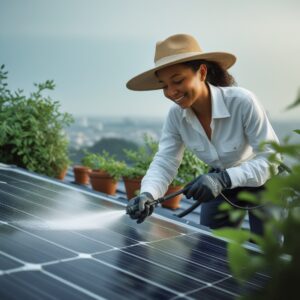Strong roof-cleaning chemicals have the potential to run off and damage plants, pets, and wildlife in gardens or local waterways. Green methods avoid such harmful side effects, keeping your outdoor spaces safe and healthy.
Some environmentally friendly solutions use less water than traditional methods. This is helpful in areas experiencing drought or with water-use restrictions. Using sustainable cleaning methods, you add to water conservation efforts.
Green roof cleaning products are biodegradable, meaning they decompose naturally without leaving toxic residues. Soil thus never gets contaminated, and the environment as a whole stays clean. Opting for eco-friendly treatments means you keep your roof looking good while also being a responsible neighbor to the planet.
Common Eco-Friendly Roof Cleaning Techniques
One popular approach is to work with a low-pressure washing system and natural cleaning solutions. Low pressure won’t damage delicate shingles or tiles like high-pressure washing can. High-pressure washing has the potential to erode roofing materials and thus shorten their life.
The natural solutions might be made up of things such as vinegar, baking soda, or oxygen-based cleaners. Vinegar, being acidic, helps break up mildew and moss, while baking soda provides a mild abrasive that softly cleans without scratching. Oxygen-based cleaners put oxygen molecules into action that lift dirt away and sanitize the roof surface without harming plants or pets.
Though more labor-intensive, manual cleaning with brushes and scrapers completely avoids chemicals and lets you very carefully address specific trouble spots. This is especially useful for roofs with complex designs or older materials that may not stand up well to much moisture or pressure.
Benefits of Low-Pressure Washing
In an effective cleaning versus roof preservation balance, low-pressure washing and environmentally safe cleaners work hand in hand. Rather than hurling water at your roof with such force that granules would fly off or tiles could be weakened, like high-pressure systems do, low-pressure systems simply wash. As such, this “softer” cleaning helps extend the life of your roof and lessen the possibility of having to bear the costs of repairs or replacement.
The eco-friendly solutions of low-pressure washing are, in general, non-toxic and demand little or no harsh rinsing, which saves water. Moreover, elements such as oxygen bleach or plant-based surfactants are fast to degrade and thus do not allow harmful byproducts to remain in the environment.
You can eliminate unsightly stains and moss without uprooting delicate plant life around your home or polluting groundwater. If you want a thorough yet gentle way to clean, this method fits the bill.
 Using Homemade Cleaners for Roofing Maintenance
Using Homemade Cleaners for Roofing Maintenance
If you prefer handling roof care with your own hands, making your roof cleaning solution at home is a smart way to keep things eco-conscious. White vinegar, baking soda, and lemon juice are very popular roof-cleaning wasteless agents, and they work great.
Fill a spray bottle with a mixture of equal parts water and white vinegar. Spray this solution onto the spots on your roof that require cleaning, allowing it to sit for 20 to 30 minutes. Once the time has passed, rinse the area gently using a hose. This natural solution is very effective at breaking down moss, algae, and lichens.
For stronger cases, sprinkle some baking soda on the area after wetting it, and then lightly scrub with a soft brush to remove the dirt. Baking soda provides deodorization and very light abrasive action, helping to enhance cleaning without the risk of damage. Lemon juice, with its gentle acidity, also helps remove stains and imparts a fresh scent.
Preventing Roof Damage Naturally
Doing preventive things introduces less of a need for heavy cleaning or harsh chemicals in the future. One simple practice would be to trim overhanging trees and branches on your roof since moss prefers shadier, damp areas.
Make sure your gutters and downspouts are clear and working properly, so water drains away from the roof, away from the places where it can pool, thus favoring the growth of algae. Another low-impact method would be to place zinc or copper strips near the ridge of your roof, because both metals effectively hinder the growth of moss without harming the environment.
Don’t walk on the roof unless you have to, as this could damage the shingles and allow moisture in. Stick to safe inspection techniques using binoculars or drones when possible.
Tips for Safe and Eco-Friendly Roof Cleaning
When cleaning your roof, prioritizing safety and sustainability together is important. Always protect yourself by wearing gloves, eye protection, and non-slip shoes. Don’t work on ladders in wet or windy conditions. Use them safely.
Select products that are safe for the environment. If you’re using homemade mixtures, do a small test area first to make sure there won’t be any damage. Before applying any substances, consider the wind direction so that spraying drift will be minimal on nearby plants or properties.
Use water carefully by making minimal applications of the cleaner and using a controllable spray nozzle to prevent excessive runoff. When rinsing, divert the water flow away from sensitive vegetation or septic systems.
If roof cleaning is in doubt, hire a professional Eco-Friendly Roof Care service provider. Such s who specialize in environmentally sensitive would methods. They would have the proper equipment and expertise to do the job cleanly, minimizing harm to the environment.
Long-Term Benefits of Eco-Friendly Roof Care
A well-maintained roof stays in good shape longer, so fewer repairs and replacements—win budget your.
Clean roofs reflect sunlight better, which can contribute to energy savings by keeping your house cooler in warm months.
Maintaining eco-friendly habits builds a positive reputation if you live in a neighborhood or community that values sustainability. It sets an example and encourages others to think about their impact on nature.
Choosing natural, safe, and mindful roof cleaning methods promotes holistic well-being—for your home, family, and the planet.